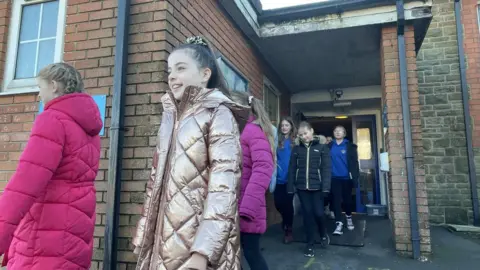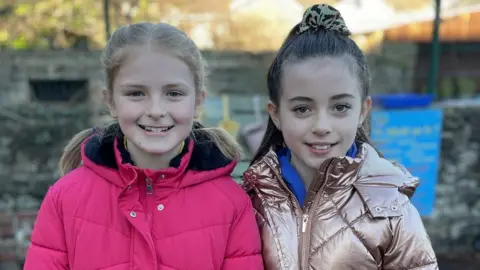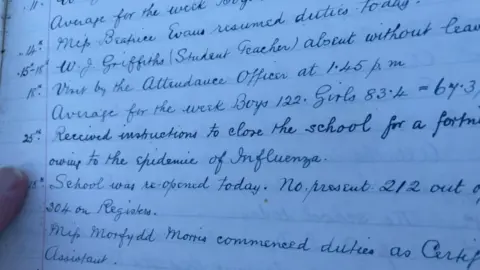Covid: 'It's as cold in the school as it is outside'
On 25 October 1918, one small school in south Wales was forced to close for weeks due to the Spanish Flu.
More than a century later, head teacher Rhian Kenny spots the entry in Ysgol yr Hendy's log book as her staff and almost 200 pupils deal with the impact of the Covid-19 pandemic.
They have welcomed all children back to class after Christmas despite fears about a return to online learning.
But in a bid to cut the risk of infection, the Carmarthenshire school is one of hundreds in Wales taking extraordinary measures to protect pupils and their families.
They include investing in raincoats to make sure pupils stay dry in their hourly outdoor breaks.

"It's been really, really hard," said Mrs Kenny.
"For the last two weeks it's been really, really wet, but regardless of the weather out they've gone.
"We've purchased additional coats to make sure they are waterproof."

When the school received carbon dioxide monitors they were "red and beeping mostly", Mrs Kenny said, indicating poor air flow.
After a visit from the council's health and safety officer, they are now waiting for air purifiers.

But in the meantime, pupils leave classrooms every hour so clean air can circulate before they go back indoors.
Schools across Wales had two planning days at the start of term to respond to the challenges posed by the Omicron variant and put measures in place.
They were also asked to look at their online learning plans, should there be a need to teach pupils remotely.

Ffion, 9, is "really happy" to be back in school and, although difficult, understands why Covid measures have been put in place.
"It gets really cold in the classroom and sometimes it's hard to work because you're just shivering on your chair," she said.
The ventilation has caused a "tremendous problem", Mrs Kenny said, because even with the windows and doors open "it's just still stale air".
"And now the weather's changed... it's a lot colder and I can honestly say it's as cold in the school as it is outside the school.
"The heating is on every single day for it just to disappear through the windows."

But despite the additional expense, Mrs Kenny said "it's what we have to do to make sure that the school is as safe as possible and that we're keeping the school open".
Ten-year-old Lily said of the changes: "We have a good routine going on.
"When you've got to come out when it's pouring down with rain and it's windy, it's hard."
With limits on mixing between year groups, Lily misses seeing her friends in Years 3 and 4, adding: "Sometimes you want to play with them or you want to have fun with them, but it is really difficult."

Suspended ceilings added to the original structure are partly responsible for poor air circulation at the 110-year-old school.
Learning about the impact of the Spanish Flu in 1918 through the school's log book has helped pupils understand previous generations faced similar challenges.
Mrs Kenny said the staff and children have been "absolutely fantastic" in adapting to the measures.
She said she understood why restrictions may need to remain in schools for longer, even as they are relaxed in other settings, because of the "concentration of people in one building".
"As long as we're kept open I don't mind because it's just lovely to hear the children - to hear their voices in school and on the school yard".

- MONUMENTAL MRS CAMPBELL: Wales' first black head teacher celebrated with iconic statue
- MOTHERS, MISSILES AND THE AMERICAN PRESIDENT: The story of Greenham told like never before

